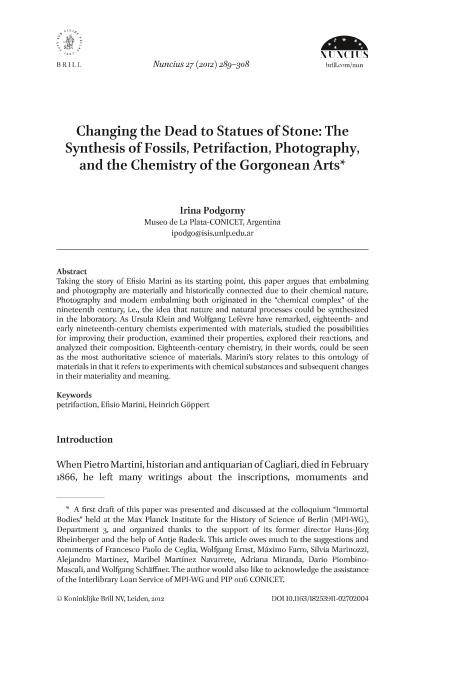Artículo
Changing the Dead to Statues of Stone: The Synthesis of Fossils, Petrifaction, Photography, and the Chemistry of the Gorgonean Arts
Fecha de publicación:
12/2012
Editorial:
Leo S Olschki
Revista:
Nuncius-journal Of The History Of Science
ISSN:
0394-7394
Idioma:
Inglés
Tipo de recurso:
Artículo publicado
Clasificación temática:
Resumen
Taking the story of Efisio Marini as its starting point, this paper argues that embalming and photography are materially and historically connected due to their chemical nature. Photography and modern embalming both originated in the "chemical complex" of the nineteenth century, i.e., the idea that nature and natural processes could be synthesized in the laboratory. As Ursula Klein and Wolfgang Lefèvre have remarked, eighteenth-and early nineteenth-century chemists experimented with materials, studied the possibilities for improving their production, examined their properties, explored their reactions, and analyzed their composition. Eighteenth-century chemistry, in their words, could be seen as the most authoritative science of materials. Marini's story relates to this ontology of materials in that it refers to experiments with chemical substances and subsequent changes in their materiality and meaning.
Palabras clave:
EFISIO MARINI
,
HEINRICH GÖPPERT
,
PETRIFACTION
Archivos asociados
Licencia
Identificadores
Colecciones
Articulos(CCT - LA PLATA)
Articulos de CTRO.CIENTIFICO TECNOL.CONICET - LA PLATA
Articulos de CTRO.CIENTIFICO TECNOL.CONICET - LA PLATA
Citación
Podgorny, Irina; Changing the Dead to Statues of Stone: The Synthesis of Fossils, Petrifaction, Photography, and the Chemistry of the Gorgonean Arts; Leo S Olschki; Nuncius-journal Of The History Of Science; 27; 2; 12-2012; 289-308
Compartir
Altmétricas




